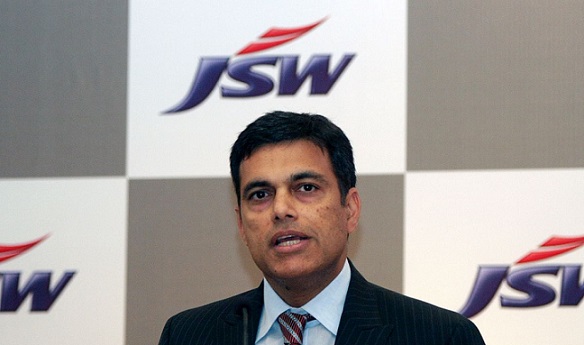By Our Correspondent
BHUBANESWAR/NEW DELHI/BARBIL: The Sajjan Jindal led JSW Group largely benefited after Prime Minister Narendra Modi led Government brought Mines and Minerals (Amendment) Act of 2015 and Mineral and Minerals (Regulation Bill)-2020 paving way for open bidding. JSW Steel’s Sajjan Jindal had himself at that time, told soon after mining auction in Odisha, that the Company can afford high premium for raw material security to run multiple operations across the Country.
JSW had won 4 major blocks earlier held by KJS Ahluwalia Group and Rungta Mines Ltd Group– Nuagaon (won on January 31, 2020),Narayanposhi ( won on February 2, 2020) and Ganua ( won on February 5,2020) and Jajang ( won January 6,2020) – with total ore reserve of 1,138.34 million tonnes. With the 4 Mines, an iron ore reserves linkage of more than 1,100 million tonnes has been secured for JSW Steel of Sajjan Jindal, sources in Barbil in Odisha’s Keonjhar said.
JSW Steel will have pay dues to Government for Nuagaon ,Narayanposhi,Ganua and Jajang blocks. Value of estimated reserves in INR Crores are as follows Nuagaon (Rs 1,85,683,47), Narayanposhi(Rs 42,571,12), Jajajng (Rs 5,511,44) and Ganua(Rs 24,982,79). This included 1% resource value, 0.5% affront payment and 0.5% performance security. For example, 1% security deposit for Nuagaon block will be around Rs 1856 Crore and NPV and stamp duty will be calculated extra.
The Union Cabinet Nod to the Ministry of Mines plan to delete the 10A (2b and 2c) Sections from the Mines and Minerals Development Regulation (MMDR) Act and removal of the definition of captive and non-captive mines, will not only hit Gold Mining, iron, ore, coal mining, Steel market, but also, particularly mineral bearing Odisha, will face the onslaught with Steel makers and mines owners expressing apprehensions over the issue of captive and non-captive mines. This was reportedly aimed at providing a free hand to Sajjan Jindal led big mining lobby in mineral bearing States including in Odisha.
Meanwhile, Mines Owners, Steel and Sponge Iron producers on Thursday expressed mixed reaction after the Union Cabinet approved the Union Mines Ministry’s proposal to bring reforms via changes in policy and amendment to the mines and minerals development regulation (MMDR) Act and Rules.
The Ministry proposed the removal of section 10A (2b) and 10A (2c) under the MMDR act which hindered the prospect of a mineral auction of over 500 mines. The MMDR Act clause 10A (2c) allowed pre-auction mines to get EC & FC clearances by 2017 and clause 10A (2b) does not have a sunset clause on pre-auction mines for starting operations.
Earlier, Section 10A (2) (b) allowed an entity to acquire a mining lease for the mines allotted prior to auction regime without any sunset clause and 10A (2) (c) allowed an entity to get the environment and forest clearance within 2 years of the auction of mines.
People having close watch on Odisha’s Mining and Industry issues, however revealed that the provision of section 10(A)2 B and C was inserted in MMDR Amendment Act 2015 to safe guard the interest of ML/PL holders whose cases were pending with different State Government at that time .
These applications were filed long back as per the prevalent act as applicable in that time. Due to crawling process of government machineries these applications could not be converted in to mining leases in time bound manner. When some massive changes took place on January 12, 2015, the interest of these cases were well safeguarded by bringing the provisions of 10 A2B and 2 C. Though there was a time limit of 2 years in case of 10 A 2C but no time line was fixed in case of 10 A 2B, they said.
Different state govt kept pending all cases of 10 A 2 B for almost 5 years and no conclusive decision was taken over these cases. Now by just one stroke of pen all these cases will be scraped. In these last 5 years, government kept a blindfold over these cases, which is why the cases couldn’t be processed timely. If Central govt didn’t want to allot these cases on mere royalty basis then why government kept these cases in saving clause under 10 A2 B in MMDR Act 2015.Those applicants have put lot of money, time and efforts to keep their respective cases alive and waited for almost 5 years after enactment of amended act, they argued.
The captive mining leases coming under 8A5 category were extended by almost 15 years ie upto 31.03.2030 mainly belonging to Tatas . Now early termination of the captive mines and scraping the provisions of right of first refusal creates lot of doubt at this stage, one of the Koira , Sundargarh based Mines owner said .
Recently Some mega steel companies mainly rivals of Tisco , like JSW Steel, Arcellor-Mittal India and few more have grabbed several big size iron ore mines in Odisha though auction .Now they are thinking that in future they may not be able to compete with Tisco ,because they have taken mines @ more than 100% premium whereas TISCO will enjoy it’s mines for another 10 years on simple royalty basis.That’s why they may not be able to compete with Tisco in long run, they said.
For instance suppose if the IBM price of 1MT of iron ore is Rs 3,000 pmt, the auctioneers have to pay 3,000 plus royalty etc.If cost of production will be added with this premium and royalty it will be around 4,500 pmt(3,000 amount of premium (@100%,) Rs 700 royalty DMF etc 800 tentative cost of production.)For 1 mt of iron ore the auctioned miners have to pay around Rs 4,500. On contrary Tisco will have to bear only Rs 1,500 towards royalty and cost of production, they said.
For making 1 mt of steel almost 2 mt of iron ore is required. Simply Rs 6,000 per mt extra cost will be borned by these auctioned miners for steel making where as Tisco having vast advantages of its infrastructures like Raliway siding and mining leases of coal,lime stone,Dolomite etc and less cost of production , long period in hand having extra edge over their competitors. In event of depressed market sentiments where the profit in steel will be less than 6,000 pmt even after Tisco can make some profit but their competitors will have to suffer the losses. Therefore these extra facilities of Tata has became a point of envy for their rivals. By hook or crook they don’t want to see Tisco to enjoy furthermore, sources added.
Earlier, several Gold mines owners in Karnataka had expressed their concerns on issues of 10A (2b and 2c) Sections from the Mines and Minerals Development Regulation (MMDR) Act as they feared huge loss since they invested crores in explorations in past 15 years and an open auction for the same gold bearing block, would put them in trouble.
The auctions of iron ore and manganese mines in Odisha in January and February fetched an average premium of about 105%. That means, in addition to taxes and cess, a lessee would also pay the state Rs 105 for every Rs 100 of ore it sold over the next fifty years. Taking prevalent iron ore prices and everything else as constant, this works out to an additional annual revenue of about Rs 7,000 crore for the state.
The last bidding for expired mines in Odisha fetched around Rs Rs 4.87 Lakh Crore revenue. These Mines blocks holds Iron Ore 1716.92 mt, Manganese 8.77 mt and Chrome Ore having 104.96 mt, which was worth Rs.4,87,082.55 Crore. Out of 23, 11 are in Keonjhar, 8 in Sundargarh ,3 in Jajpur and 1 in Mayurbhanj.
The 2015 amendment made two exceptions: Under Section 10A (2b) where reconnaissance or prospecting had been carried out successfully, the lessee could move up to a prospecting or mining lease respectively. Ironically, subsection 2c offered a window of two years, or until January 12, 2017, to those that had progressed beyond and held a letter of intent.
Royalty is charged on price inclusive of royalty because miners pass on the cost anyway. Any discounting of this would lead to a loss of revenue for the state. New lessees have offered premiums of five to six times of royalty presumably because they could afford to.
The proposal includes the removal of the distinction between captive and non-captive mines, an incentive for early mineral production for miners by way of 50 percent rebate on revenue share for the quantity produced earlier than the schedule. Provision of penalty is also proposed for not maintaining prescribed production for 3 consecutive quarters, which may lead to termination of mining lease.
Tata Steel has large captive mines spread across Jharkhand and Odisha feeding its plants at Jamshedpur, Kalinganagar and Angul. It also mines ferro alloys such as chromite and manganese for captive use.In FY19, the company mined 23.3 million tonnes of iron ore and 6.54 million tonnes of coal, meeting 100 per cent and 27 per cent of its requirements, respectively.
The Mines Ministry is also streamlining provision for additional royalty on an extension of mining leases under section 8A of the MMDR act and rules. The amendment to the section will allow states to charge additional royalty in lieu of mining lease extension. This comes at the back of NMDC’s Donamalai mine’s lease expiry in Karnataka that led to the long disruption of iron ore mining. This move will ensure there is no such disruption in mineral production future and also bring a level playing field for auctioned and government dispensation allotment of mines to PSUs.
The Mines Ministry will also clarify the controversial 21(5) section under the MMDR act. The amendment will clarify that mining within the mining lease area cannot be illegal under Section 21 (5) of the MMDR Act. In the past, like in the case of Coal India, violation of environment/forest clearance has led to the state government of Odisha to seek fine in the tune of Rs 20,000 crore.
The proposal also allows the transfer of mines with no additional royalty for mining companies. Earlier, the private companies’ transfer of auctioned mineral mines attracted 80% additional royalty provision.
The industry has expressed its concerns on high taxation on mining, a proposal to rationalise stamp duty is likely to be considered by the finance ministry. The mines ministry aims to auction over 500 mineral mines and is targeting to double mineral production in India in the next 4-5 years period. The idea behind policy reforms is also to save forex outgo which is incurred by way of increased imports of Aluminum and steel products and the aim is ultimately to become an exporter.
The ministry also plans to reallocate mineral mines of Public Sector Undertakings (PSUs) if it fails to bring the mines online in 5 years. The government also plans to develop the National Mineral Index for the purpose of statutory and auction payments as the Average Sale Price is considered distorted due to various reasons. The changes to the rules and act of MMDR will be laid in the parliament for amendment before it is made public by the government and it is expected in the upcoming budget session.






























